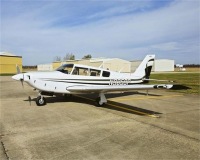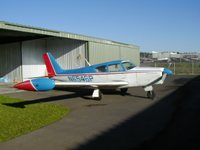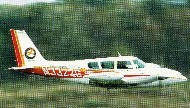Last Saturday my wife and I were flying for Atizapan (MMJC - Near Mexico City) to Puerto Vallarta (MMPR) at 12,500 feet, a 2.2 hrs flight in the Comanche; beautiful day, no turbulence, but being shortly after breakfast, the need to pee became urgent about half an hour before landing as we were entering the Sierra. I didn't want to land in such uncomfortable condition, so I got my Little John, moved the seat backwards (the plane was in auto pilot) and proceeded to execute the ritual. While busy doing my thing, the change tank alarm came and went, and I never saw it. I was flying on my RH aux. tank that had gas for about 40 minutes, I change them every half hour. (MMJC is at 8,120 feet and is only 4,200 feet long, so I try to take off with about half tanks.
When I was ready, moved the seat forward and about 8 minutes later the engine stopped, surged, and stopped for good. I got the scare of my life, because it was such a surprise that it took me about ten seconds to realize what had happened. In the meantime I was scanning the instruments and looking for a place to land (not very evident in that neighborhood), turning the fuel pump on, enriching the mixture, changing the tank, etc. I think that the whole episode took probably 20/25 seconds. My wife who does NOT like flying small aircraft, but goes everywhere with me regardless, didn't say a word, took off her glasses, put her iPad away and looked at me intently, she later told me that she thought: "that's it" then the engine restarted.
Lessons learned: 1. Pay attention to the fuel management, regardless of the urge to pee, 2. It REALLY takes between 3 and 5 seconds just to react to a problem, 3. Even at 2,000 feet AGL there is plenty of time to evaluate the situation before the aircraft "falls from the sky" 4. It is really a different sound and feeling when the engine quits at 165 knots ground speed, than when you are simulating an emergency at idle. Hopefully it will never happen to me again, but at least now I know how long it takes to restart.
Very unpleasant but formative experience
10 posts
• Page 1 of 1
Very unpleasant but formative experience
Andres
N9359P
N9359P
-

Andres Darvasi - Posts: 75
- Joined: Tue Feb 12, 2013 5:58 am
- Location: Mexico City, Mexico
Re: Very unpleasant but formative experience
That really is an extremely loud silence. Thanks for sharing the experience.
Jim Hiatt
-

JIMICS2452 - ICS member

- Posts: 254
- Joined: Sat Mar 09, 2002 9:26 pm
- Location: Pine Shadows Airpark - North Fort Myers, FL
Re: Very unpleasant but formative experience
Glad it worked out to a happy ending.
Even though your wife may not be thrilled with flying as an intelligent person in the plane - she married you didn't she? - she should know the basics and assist as needed. I'd put her in charge of tank changes under your supervision and she should know the basics of landing in the event you are incapacitated ... just a thought.
Even though your wife may not be thrilled with flying as an intelligent person in the plane - she married you didn't she? - she should know the basics and assist as needed. I'd put her in charge of tank changes under your supervision and she should know the basics of landing in the event you are incapacitated ... just a thought.
Pat
Patricia Jayne (Pat) Keefer ICS 08899
PA-39 #10 Texas
Patricia Jayne (Pat) Keefer ICS 08899
PA-39 #10 Texas
-

N3322G - ICS member

- Posts: 1911
- Joined: Thu May 08, 2008 1:58 pm
- Location: Fort Worth, Texas area
Re: Very unpleasant but formative experience
Pat, I have been trying for years, she refuses.
A few weeks ago I convinced to take the yoke and try to fly straight and level, she did it for about five minutes, not too bad I should say, but she feels extremely uncomfortable and scared.
We'll keep on trying!
A few weeks ago I convinced to take the yoke and try to fly straight and level, she did it for about five minutes, not too bad I should say, but she feels extremely uncomfortable and scared.
We'll keep on trying!
Andres
N9359P
N9359P
-

Andres Darvasi - Posts: 75
- Joined: Tue Feb 12, 2013 5:58 am
- Location: Mexico City, Mexico
Re: Very unpleasant but formative experience
Andres - after 50 years of downhill skiing, my husband finally got me to wear a ski helmet by telling me 'I want you to live' - just a thought.
Pat
Patricia Jayne (Pat) Keefer ICS 08899
PA-39 #10 Texas
Patricia Jayne (Pat) Keefer ICS 08899
PA-39 #10 Texas
-

N3322G - ICS member

- Posts: 1911
- Joined: Thu May 08, 2008 1:58 pm
- Location: Fort Worth, Texas area
Re: Very unpleasant but formative experience
I will try that!
When I had the Cessna 210 I wrote SEVEN pages of instructions, step by step, in order to get the aircraft on the ground, after that I tried to get her to go over those steps in order to familiarize herself at least with the locations, names, functions, etc. of the instruments, levers and switches. I was not successful.
I must add that my wife is a psychologist and psychoanalyst, and usually very receptive to new things and ideas… however, flying, to her, is unnatural, scary and… "I most likely feel the same that you feel in a roller coaster", which scares the daylights out of me!
I will certainly keep on trying.
When I had the Cessna 210 I wrote SEVEN pages of instructions, step by step, in order to get the aircraft on the ground, after that I tried to get her to go over those steps in order to familiarize herself at least with the locations, names, functions, etc. of the instruments, levers and switches. I was not successful.
I must add that my wife is a psychologist and psychoanalyst, and usually very receptive to new things and ideas… however, flying, to her, is unnatural, scary and… "I most likely feel the same that you feel in a roller coaster", which scares the daylights out of me!
I will certainly keep on trying.
Andres
N9359P
N9359P
-

Andres Darvasi - Posts: 75
- Joined: Tue Feb 12, 2013 5:58 am
- Location: Mexico City, Mexico
Re: Very unpleasant but formative experience
Its my humble opinion that the fuel management component of our plane is the most challenging issue regarding cockpit management in the Comanche.
I have also heard that "silence of rushing air" as a new owner who made the mistake of trusting a sticky fuel gauge. I offer the following cockpit management rules I have implemented for myself to avoid it ever happening again.
1. I only trust manual fuel calculations that cannot fail. Fuel gauges, alarms, and panel lights are the last line of defense against fuel starvation in my cockpit, not the first. They can and will fail. Just a matter of time. I have installed a manual, non electric clock that I use to make fuel burn calculations on and then set the manual red hand on the clock to that tank's maximum fuel burn time, less ten minutes as a buffer. Whenever I switch tanks I reset the red hands on the clock and I back it all up on my wristwatch. I also physically open view each tank on pre-flight. A sticky fuel gauge and a tank leak could overcome my system, so again, I dont trust, but always verify manually.
2. When I'm at a quarter tank, (by time and confirmed by gauge) I place my hand on the dog bowl where the fuel selector is, and I don't remove it until I switch tanks. I cant tell you how many times other issues in the cockpit have take my focus away from fuel management. It happens to all of us. My hand on the fuel selector has been a constant reminder that has helped more that once. For some reason I can tell myself not to remove the hand and it sticks. Maybe this might help you.
3. And lastly I insist that my wife watches the fuel gauge. She doesn't want to be responsible for safety of flight or flying the aircraft either so I don't make it complicated. I ask her to do two things...make sure the gauge is moving downward and talk to me at a quarter of a tank. I find she cant stop looking at the fuel gauge, its just human nature. Again, she is part of that last line of defense, I'm not depending on her scan but I have added it to my cockpit defense against fuel starvation.
I have found that if I have a list of fail safes that I perform faithfully it becomes almost impossible to run out of gas by accident. Hope some of this could be useful for you.
I have also heard that "silence of rushing air" as a new owner who made the mistake of trusting a sticky fuel gauge. I offer the following cockpit management rules I have implemented for myself to avoid it ever happening again.
1. I only trust manual fuel calculations that cannot fail. Fuel gauges, alarms, and panel lights are the last line of defense against fuel starvation in my cockpit, not the first. They can and will fail. Just a matter of time. I have installed a manual, non electric clock that I use to make fuel burn calculations on and then set the manual red hand on the clock to that tank's maximum fuel burn time, less ten minutes as a buffer. Whenever I switch tanks I reset the red hands on the clock and I back it all up on my wristwatch. I also physically open view each tank on pre-flight. A sticky fuel gauge and a tank leak could overcome my system, so again, I dont trust, but always verify manually.
2. When I'm at a quarter tank, (by time and confirmed by gauge) I place my hand on the dog bowl where the fuel selector is, and I don't remove it until I switch tanks. I cant tell you how many times other issues in the cockpit have take my focus away from fuel management. It happens to all of us. My hand on the fuel selector has been a constant reminder that has helped more that once. For some reason I can tell myself not to remove the hand and it sticks. Maybe this might help you.
3. And lastly I insist that my wife watches the fuel gauge. She doesn't want to be responsible for safety of flight or flying the aircraft either so I don't make it complicated. I ask her to do two things...make sure the gauge is moving downward and talk to me at a quarter of a tank. I find she cant stop looking at the fuel gauge, its just human nature. Again, she is part of that last line of defense, I'm not depending on her scan but I have added it to my cockpit defense against fuel starvation.
I have found that if I have a list of fail safes that I perform faithfully it becomes almost impossible to run out of gas by accident. Hope some of this could be useful for you.
-

Randy Johnson - Posts: 176
- Joined: Thu Apr 14, 2011 1:57 am
- Location: Boston Area (BEV)
Re: Very unpleasant but formative experience
Randy,
Thanks for the tips and advice.
Since I bought the plane, i implemented the use of a paper form which I religiously use to keep track of fuel usage, it has the four tanks, starting quantity that gets verified with a calibrated stick at each preflight, and where the fuel used per the EI fuel management instrumentt (very accurate) gets deducted at every tank change. This gives me a very precise fuel situation at all times.
Moreover, at the last annual, the fuel sensors where all overhauled and now the gauge is accurate.
On top of all of the above I have half hour alarms in the Garmin 696, 530 and 430...
So, I humbly confess that the real problem here was the pilot being distracted and not on top of the situation.
As Pat and you suggested, I will enlist the help of my wife to watch the gauge and the alarms, and will also investigate the possibility of programming an alarm in the EI fuel computer, which shows a blinking red light in front of my eyes when an alarm is triggered.
Thanks for the tips and advice.
Since I bought the plane, i implemented the use of a paper form which I religiously use to keep track of fuel usage, it has the four tanks, starting quantity that gets verified with a calibrated stick at each preflight, and where the fuel used per the EI fuel management instrumentt (very accurate) gets deducted at every tank change. This gives me a very precise fuel situation at all times.
Moreover, at the last annual, the fuel sensors where all overhauled and now the gauge is accurate.
On top of all of the above I have half hour alarms in the Garmin 696, 530 and 430...
So, I humbly confess that the real problem here was the pilot being distracted and not on top of the situation.
As Pat and you suggested, I will enlist the help of my wife to watch the gauge and the alarms, and will also investigate the possibility of programming an alarm in the EI fuel computer, which shows a blinking red light in front of my eyes when an alarm is triggered.
Andres
N9359P
N9359P
-

Andres Darvasi - Posts: 75
- Joined: Tue Feb 12, 2013 5:58 am
- Location: Mexico City, Mexico
Re: Very unpleasant but formative experience
I agree with Randy, except for the statement that manual calculations cannot fail (I did see where he watches the gauges also in addition to calculating fuel). About thirty years ago I had a Cherokee 180. After flying for about two hours, the fuel gauge read almost empty. Of course, having started with full tanks, and being an inexperienced pilot at the time, it had to be a faulty gauge. On landing approximately 20 minutes later and fueling the plane, I saw the error of my ways when the plane had two gallons of usable fuel left. We then discovered the fuel leak at the loose connection of the fuel line at the carburetor. God was truly with us on that flight, as it could have easily ended in disaster from either fuel starvation or an engine fire. Never trust the fuel gauges if they show more than calculated fuel, but also do not trust your calculations when the gauges show less than calculated. Also, the movie "Falling From The Sky, Flight 174" is the true story of an airliner running out of fuel due to a mistake in calculating liters versus gallons.
- Jerry Mazza
- ICS member

- Posts: 39
- Joined: Wed Oct 27, 2010 6:03 pm
Re: Very unpleasant but formative experience
Thanks all, having had my own unpleasant experience a while back (on approach) I developed a system with watch, paper etc. similar to those described by others here. Passengers have often asked me why all the fuel ceremony, but reading the methods here I see we have come up with a common solution.
Joe
Joe
- papajoe
- ICS member

- Posts: 4
- Joined: Tue Nov 10, 2009 5:38 am
10 posts
• Page 1 of 1
Return to Maintenance - General
Who is online
Users browsing this forum: No registered users and 25 guests
